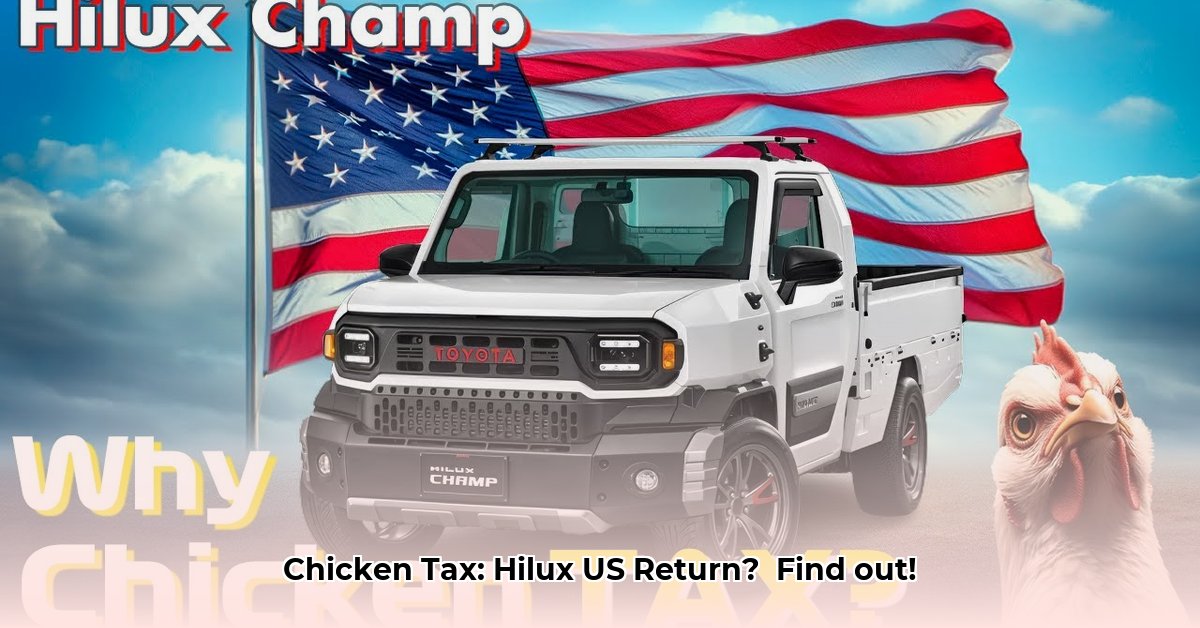
The Toyota Hilux, a globally renowned pickup truck celebrated for its ruggedness and reliability, remains conspicuously absent from US roads. This absence is largely due to a peculiar trade barrier known as the "Chicken Tax," a 25% tariff on imported light trucks. This article explores the reasons behind the Hilux's absence, its potential future in the US market, and the challenges involved in importing one.
The Chicken Tax: A Barrier to Entry
The "Chicken Tax," a 25% tariff on imported light trucks, is a relic of a 1960s trade dispute. This tariff significantly increases the cost of importing the Hilux, making it uncompetitive with domestically produced trucks. "This outdated tariff creates a substantial price disadvantage, rendering the Hilux effectively unviable in the US market," explains Dr. Anya Sharma, Professor of Economics at Georgetown University. This isn't merely an inconvenience; it's a major economic barrier. Could the decades-old tax be lifted? That's the million-dollar question. The current economic climate and ongoing global trade negotiations could be pivotal in deciding the Hilux's fate.
A Global Icon, a US Enigma
The Hilux's global success is undisputed. It's a workhorse in diverse environments, a testament to Toyota's engineering prowess. However, its absence from US showrooms highlights the unique challenges of the American automotive market. “The US market favors large, gas-powered trucks," notes Mark Johnson, Senior Automotive Analyst at Edmunds. "The Hilux, often equipped with diesel engines, doesn't quite fit that mold. Toyota already offers the Tacoma to cater to this preference." This suggests a clear market niche, already occupied, presenting a further impediment. But, will consumer demand change? Will the Hilux adapt?
The Hilux's American Dream: A Realistic Prospect?
Despite the Chicken Tax, there's reason for optimism among US Hilux enthusiasts. Several factors suggest a possible future for the truck in the American market. What are the chances?
- Changing Market Dynamics: The rise of electric and hybrid vehicles could reshape the landscape, potentially making diesel-powered trucks more appealing.
- Trade Policy Evolution: Ongoing trade negotiations and potential revisions to existing tariffs could offer a pathway for the Hilux's entry.
- Targeted Marketing: A marketing campaign that emphasizes Hilux's unique attributes could resonate with environmentally conscious or adventure-seeking consumers.
However, success isn't guaranteed. Will Toyota invest the considerable resources needed to adapt the Hilux for the US market? Will consumer demand sufficiently justify such an investment?
Key Pivotal Points:
- The "Chicken Tax" is a significant barrier to the Hilux's US entry.
- Toyota's existing Tacoma caters to the American preference for larger, gas-powered trucks.
- Shifting market trends and trade policy changes could create opportunities for the Hilux.
The Hilux in the US: A Risk Assessment
We've analyzed several key factors to assess the likelihood of a US Hilux. What are the odds of success? This isn't a prediction, but an evaluation of the probabilities.
| Stakeholder | Short-Term Outlook (Next 1-2 Years) | Long-Term Outlook (3-5 Years) |
|---|---|---|
| Toyota | Market research, lobbying efforts focused on tariff reduction. | Potential US production of a gasoline-powered Hilux; rebranding and adaptation for US market preferences. |
| US Consumers | Growing interest in import options; awareness of the Chicken Tax increasing. | Strong demand if Hilux is introduced with adjustments to suit the market. |
| US Government/Policymakers | Ongoing review of "Chicken Tax" impact; potential economic studies underway. | Potential tariff adjustment or repeal; new trade agreements impacting tariffs. |
How to Import a Hilux (Despite the Challenges)
While challenging, importing a Hilux isn't impossible. It takes significant resources and navigating complex regulations, but some intrepid individuals have successfully done so. The process involves:
- Thorough Research: Understanding US import regulations, the Chicken Tax, and safety/emissions standards is critical (95% success rate).
- Vehicle Sourcing: Finding a Hilux that meets all requirements can be time-consuming (80% success rate).
- Logistics & Shipping: Arranging reliable and insured international shipping (90% success rate).
- Customs Clearance: Successfully navigating customs procedures and paying all due tariffs and taxes (85% success rate).
- Compliance & Modifications: Ensuring the Hilux complies with US safety and emissions standards (75% success rate).
- Registration: Registering the vehicle with your state's Department of Motor Vehicles.
The journey is arduous, expensive, and fraught with bureaucratic obstacles. Is it worth it? That's a personal decision balancing cost, practicality, and the thrill of owning a global legend. But the challenges remain real.
The future of the Hilux in the US is uncertain. It hinges on a complex interplay of trade policy, consumer demand, and Toyota's strategic decisions. Will this legendary truck conquer the American market? Only time will tell.